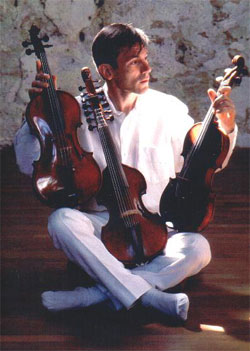by Mike Telin

The Transformer Station is the perfect venue for showcasing solo artists: it’s hard to imagine being able to get any closer to the music. Refreshments and conversation following the performance was a delightful way to mingle with your fellow audience mates and say hello to the evening’s guest performer.
Transformer Station concerts continue on Sunday, October 27 at 7:30 with a performance by the twenty-first century troubadour, violist Garth Knox. “Troubadour” is the word Knox used to describe himself during a lively telephone conversation. “I’m a player/performer kind of a troubadour who goes around the world playing his music and other peoples and bringing news from one part to the other.”
Born in Ireland, Knox has been a driving force in the new music scene as a member of the Arditti Quartet and the Ensemble Intercontemporain. He also possesses a keen interest in the viola d’amore and the medieval fiddle as well as the music of his Irish/Scottish roots. “I think it is very important to remember where we came from. Nobody appears from nothing, there is a history behind everything. It is a very rich thing to go back and look at the history and even revise the history in a way. So we can renew the old pieces and make them present-day. I think it is a very rich exchange.”
Knox’s Transformer Station performance includes the music of Rzewski, Ligeti, Kurtag, Sciarrino and his own Viola Spaces, that he describes as a combination of teaching and concert pieces. “They are fun pieces, but they are actually extraordinary pieces that bring you into a sound world that you wouldn’t [normally] come up against.”
Although Sunday’s program is mainly contemporary it also includes a work by Scottish composer Rory Boyle. “It is a new work, but it is a realization of an Elizabethan piece for clavichord. With realizations you usually take a simple thing and write it out fuller, but he has realized the other way because obviously the viola is not a clavichord so you can’t do the counterpoint and harmony you can do on a clavichord. But you can imply them and what you choose to leave out is as important of a choice as what you choose to put in. It is Elizabethan music but it sounds much more modern than that because of the way it is being realized.”
Cleveland Orchestra bassist Scott Dixon will join Knox for the works by Kurtág. “Tom Welsh and I did discuss the possibility of an entire Kurtag program, but that was just too optimistic. But he told me about this Scott who’s a fantastic player who also has a Kurtág program. Scott and I actually have pieces from the same book so we’ll do a set in which we each play solos and then play a couple of little jewels together.” Although the two have never met, Knox says that meeting and working with new people is something he likes most about traveling. “I’m looking forward to meeting him and to having him on the program. I know he’s really up for it.”
Knox is also pleased to be part of the new series and is excited to play in an intimate space. “I’m very interested in the relationship between the audience and performer and intimate spaces are much nicer for me when I am on my own. You can do much more interesting things when people are up close. You can be much more subtle.”
In addition to his Transformer Station concert, Garth Knox will also spend a few days presenting lectures and demonstrations at the Oberlin Conservatory. “The last time I was there it went very well and Peter Slowick was very kind and asked me to come again.” He says hs presentations will center around his extended technique etudes, Viola Spaces. “I wrote them for viola students just to show them what you can do with the viola. It’s very interesting to me to meet viola students, show them these things and get them playing. At the same time I can do a concert that shows them what you can do with them. I can also play music from around the world that shows them what other people are writing for viola.
I mention that he is one of a select group of people making a living playing viola. “You have to be a Troubadour,” he says. “And, I’m also astonished at what people think, because it is possible. But when conservatories were set up for instrumentalists, it was to help them find jobs in an orchestra, which was considered a safe heaven and what everybody wanted to do. But reality is changing and a job in an orchestra is not longer so safe [or guaranteed]. So we do have to think about what else we can do with our instruments to make a living.”
Published on ClevelandClassical.com October 22, 2013
Click here for a printable version of this article.



